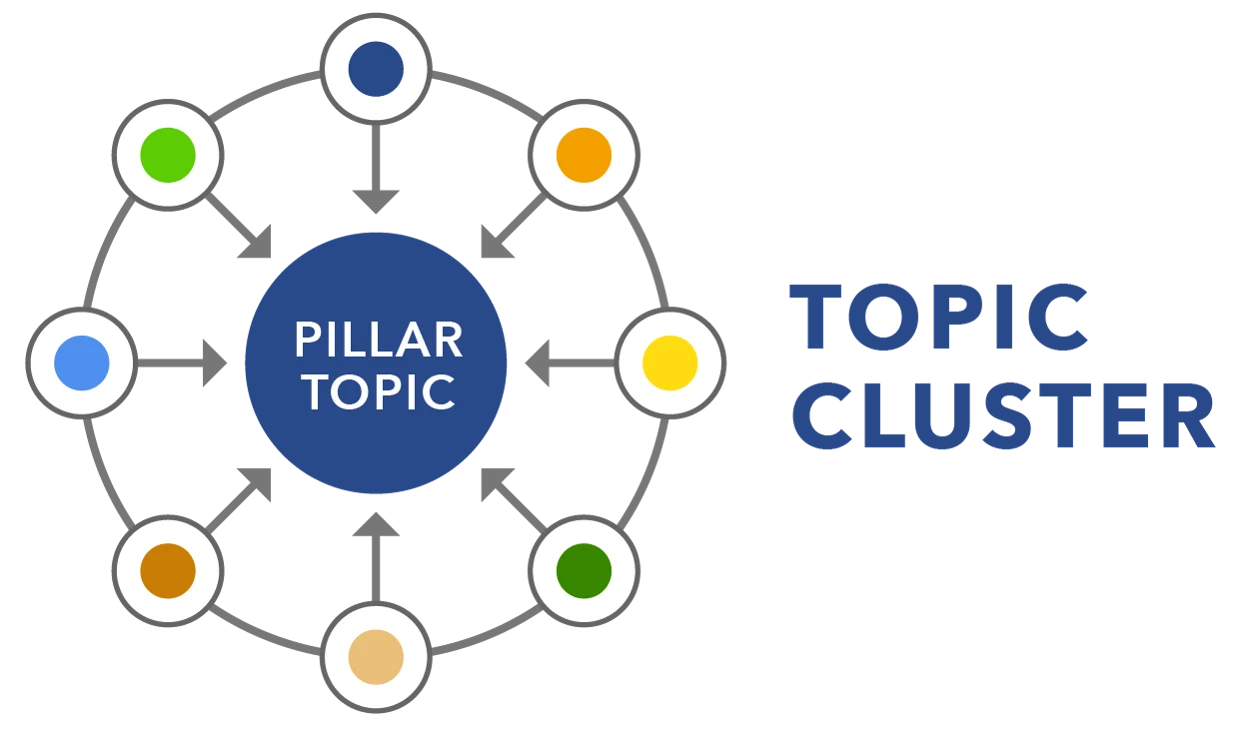Mastering Topic Clusters: A Complete Guide to Effective SEO Strategy
In this guide, we dive deep into the powerful world of topic clusters, a crucial strategy for anyone aiming to enhance their content marketing and SEO efforts. Topic clusters streamline your site’s structure by organizing content around a central pillar page linked to related subtopics, creating a network of information that boosts both search engine visibility and user engagement. By implementing this approach, you can demonstrate your expertise, target specific search queries more effectively, and offer your visitors a more cohesive browsing experience.
Whether you’re new to content strategy or looking to refine your approach, this post will equip you with the knowledge and tools to effectively create and optimize topic clusters, setting the stage for improved search rankings and stronger audience connections.
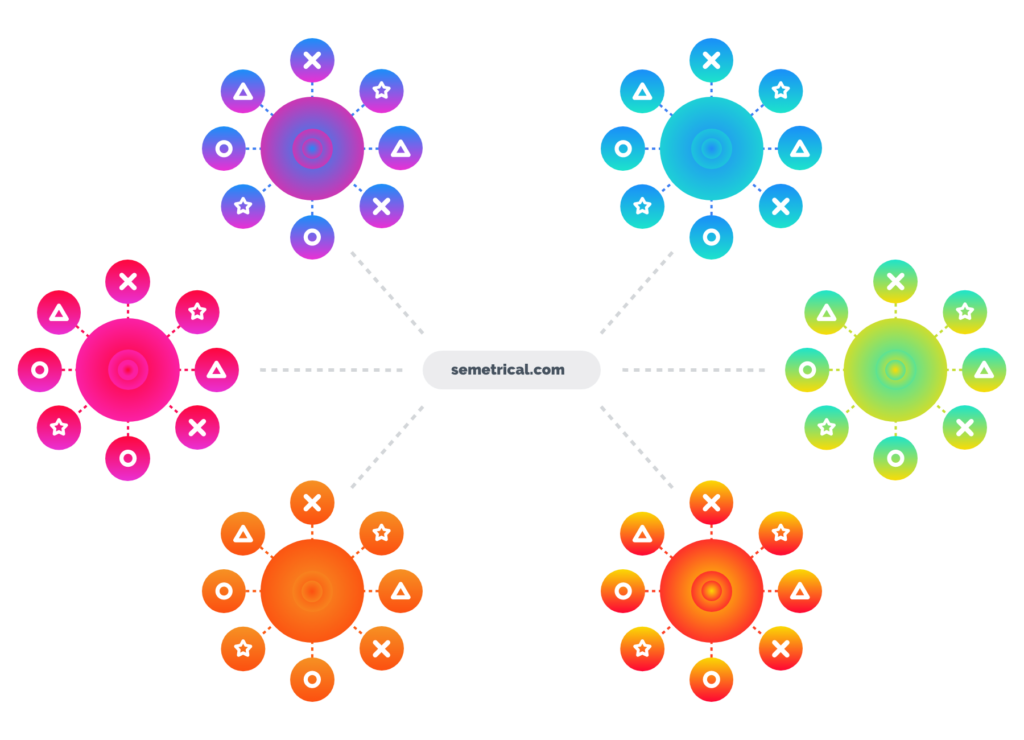
What Are Topic Clusters?
Topic clusters are a strategic approach in content marketing, where a group of thematically related pages focus on a particular subject, linked through a central pillar page. This structure includes the pillar page at the core, supported by multiple cluster pages that delve into related subtopics, all interconnected through an internal linking structure. This method not only showcases your expertise on a topic to search engines but also keeps site visitors engaged by making related information readily accessible.
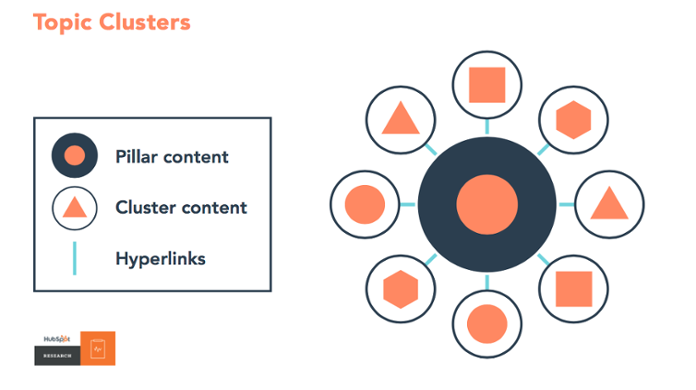
The Importance of Topic Clusters for SEO
Implementing a topic cluster strategy can significantly enhance your site structure and search engine visibility. By organizing content around a core topic and its related subtopics, you establish authority and improve search engine rankings. This strategy not only makes your content more discoverable but also signals to search engines the breadth and depth of your knowledge, boosting your SEO topic clusters.
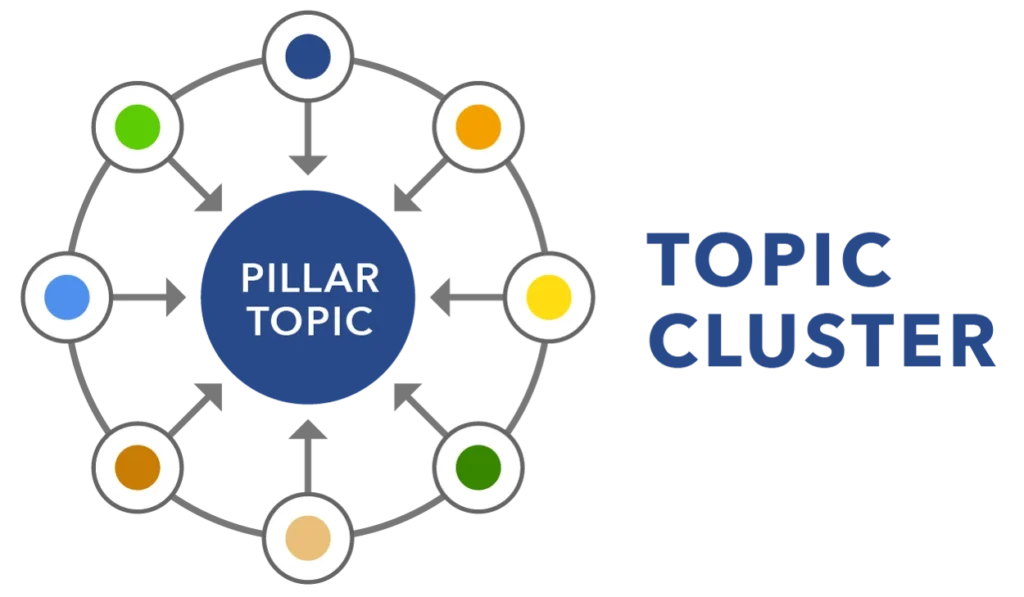
Identifying Core Pillar Topics
When starting with topic clusters, your first move is to pinpoint a core topic that’s broad yet specific enough to branch into multiple cluster pages. Think of it as choosing a sturdy trunk for your tree—strong enough to support many branches. This topic should resonate with your target audience and mirror their search intents, laying a solid foundation for your content to flourish.
How do you choose the right pillar page topic? Dive into some keyword research. Tools like SEMrush or Ahrefs are perfect for exploring what your audience is searching for. Look for relevant keywords and phrases that are popular yet not too broad, ensuring they align closely with the central theme you plan to expand upon.
Once you’ve nailed down your topic, it’s about making it as accessible and informative as possible. Your pillar page should not only address the basics but also offer gateways (through links) to deeper dives on related subtopics. This doesn’t just help your readers; it also sends signals to search engines that you’re a credible source on the topic, potentially boosting your search engine rankings.
Conducting Keyword Research
Now, let’s dive deeper into keyword research—a crucial step to ensure your topic clusters are both relevant and comprehensive. This phase is all about uncovering specific keywords that your potential readers are actively searching for. By targeting these keywords, you’re better positioned to meet your target audience’s needs and enhance your search engine results.
Start with a broad search query related to your core topic and use keyword tools to discover variations and related keywords. Focus on finding long-tail keywords that offer clear intent and lower competition, which can be golden opportunities for your cluster pages. Each of these keywords will address a different facet of your main topic, providing detailed information that enriches your site’s content.
For example, if your pillar page is about “Sustainable Gardening,” your keyword research might reveal related searches like “best plants for eco-friendly gardens” or “how to conserve water in the garden.” These phrases pinpoint user intent, guiding you to create cluster content that directly answers these queries.
Remember, good keyword research helps organize your internal linking structure. As you map out the links between your pillar page and cluster content, these keywords will guide the connections, making your site a tightly-knit web of relevant information, thus improving your search engine visibility.
Creating Pillar and Cluster Content
Once your keyword groundwork is laid, it’s time to build out your pillar page and cluster content. The pillar page acts as your content hub, providing a broad overview of the core topic while linking to in-depth cluster articles that explore related subtopics.
Crafting Your Pillar Page:
Your pillar page should be comprehensive and navigable. Start with an engaging introduction that outlines the core topic, followed by a table of contents that links to different sections of the page. Each section should cover a key aspect of the topic, offering enough detailed information to satisfy initial queries while enticing readers to click through to cluster pages for more depth.
Developing Cluster Pages:
Each cluster page addresses a specific query or subtopic, identified during your keyword research. These pages should provide detailed, quality content on their respective subjects, linking back to the pillar page and to each other where relevant. This creates a rich network of internal links that boosts SEO by showing search engines the internal linking structure of your site’s content.
For instance, if your pillar page is about “Smart Home Automation,” cluster pages might include topics like “Choosing the Best Smart Lighting System,” “Security Benefits of Smart Locks,” or “Integrating Smart Devices with Voice Assistants.” Each page should not only focus on the topic but also include calls to action, guiding readers to related content, enhancing their journey, and encouraging them to explore further.
Ensuring Content Quality:
As you develop your pages, focus on creating quality content that engages and informs. Use visuals, infographics, and videos to enrich the text and improve user intent satisfaction. Remember, each page should be optimized for both search engines and readers, with strategic keyword usage that doesn’t sacrifice readability for search engine rankings.
Optimizing Internal Linking
Effective internal linking is crucial for maximizing the SEO benefits of your topic clusters. It not only helps search engines understand the structure of your site but also enhances the user experience by making it easier to navigate between related content.
Structuring Internal Links:
Start by linking from your pillar page to each cluster page. These links should use descriptive anchor text that reflects the topic of the cluster page, helping search engines and users grasp the content’s focus at a glance. For example, if your pillar topic is on “Digital Marketing,” links to cluster pages might include anchor texts like “Email Marketing Strategies,” “SEO Basics for Beginners,” and “Social Media Advertising Tips.”
Enhancing User Engagement:
Internal links also guide users through your website, increasing the time they spend interacting with your content. This can lead to lower bounce rates and higher engagement rates, which are positive signals to search engines. Ensure that each cluster page links back to the pillar page and to other relevant cluster pages. This circular linking structure keeps users within your content ecosystem, potentially increasing page views and organic traffic.
Boosting SEO with Internal Links:
By strategically using internal links, you can spread link equity (or “SEO juice”) throughout your site. This not only helps the pillar page rank higher but also boosts the search engine rankings of the cluster pages. Make sure that the linking is logical and adds value to the user’s journey, rather than just being done for SEO purposes.
Monitoring and Adjusting:
Finally, regularly review your internal linking structure to ensure it remains relevant and effective. As you add new content or refine existing content, update your links to reflect these changes. This continual optimization helps maintain a clean, organized site that search engines can easily understand and rank.
Monitoring and Optimizing Performance
After establishing your topic clusters, the next essential step is to monitor their performance and make ongoing optimizations to ensure they continue to deliver value.
Tracking Performance Metrics:
Use analytics tools like Google Analytics to track key performance indicators such as organic traffic, page views, bounce rates, and search engine rankings. These metrics will give you insights into how well your content is performing and which areas may need improvement.
Analyzing User Behavior:
Pay close attention to how users interact with your cluster content. Look at metrics like time on page, path analysis, and conversion rates from your pillar page to cluster pages. This will help you understand user intent and satisfaction, guiding adjustments to meet their needs better.
SEO Health Checks:
Regularly perform SEO audits on your topic clusters to check for issues such as broken links, outdated content, and poor search engine visibility. Tools like SEMrush or Moz can provide comprehensive audits that highlight areas for improvement and ensure your content remains optimized for the latest search engine algorithms.
Refining and Updating Content:
Based on the data collected, refine your content to better target relevant keywords and search queries. Update your pillar page and cluster pages to include fresh, high-quality content that addresses emerging trends and user questions. This not only keeps your content relevant but also helps in maintaining or improving your search engine rankings.
Leveraging Feedback for Improvement:
Gather feedback directly from users through surveys or comment sections to gain insights into how they perceive your content. Use this feedback to tailor your topic clusters more effectively, ensuring they resonate with your audience and meet their expectations.
How to Create a Topic Cluster
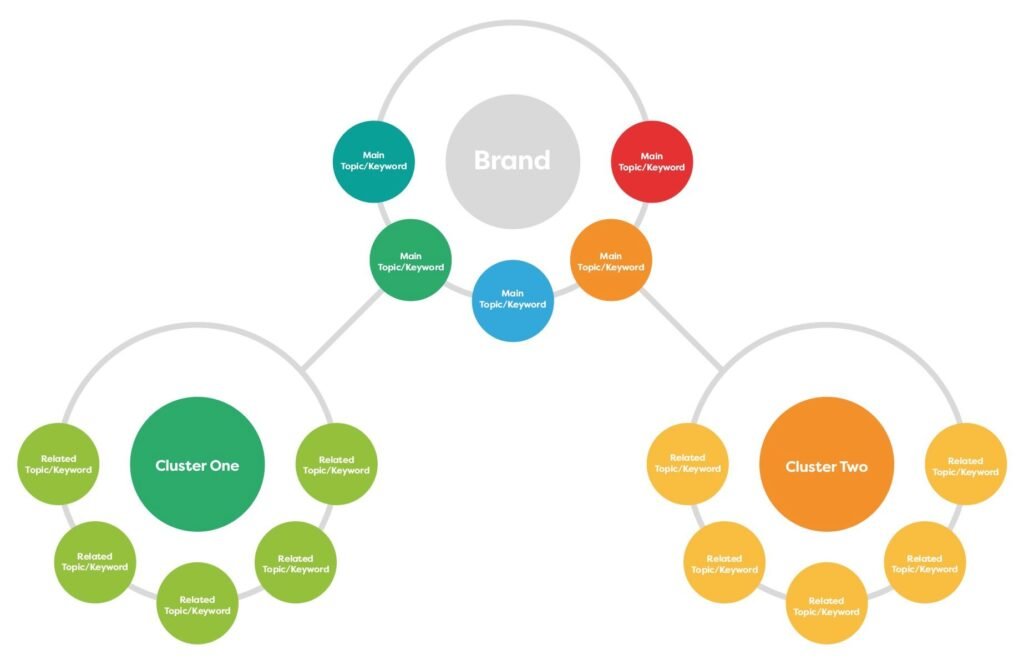
To create a topic cluster:
- Identify a Broad Topic: Start with a broad subject to anchor your cluster.
- Develop a Central Pillar Page: This page should offer a comprehensive overview of the topic, acting as a gateway to more detailed cluster content.
- Generate Cluster Content: Focus on specific aspects of your core topic, providing in-depth information on each.
- Implement Internal Linking: Connect your pillar page with cluster content through targeted internal links, using relevant keywords to strengthen the relationship between pages.
The Role of Pillar Pages in Topic Clusters
A pillar page serves as the foundation of your topic cluster, containing detailed information about the core topic and hyperlinks to cluster pages. This standalone page aims to satisfy user intent by covering the topic extensively in one place, often including a table of contents to enhance user experience.
Creating Quality Content for Your Topic Cluster
Quality content is at the heart of a successful topic cluster strategy. Begin with a well-crafted pillar page, then gradually add cluster pages that explore related subtopics. Each piece of content should be informative, engaging, and optimized for SEO, using relevant keywords and internal linking to tie the cluster together.
Measuring the Performance of Your Topic Cluster
To gauge the effectiveness of your topic clusters, monitor key performance indicators like search engine rankings for target keywords, organic traffic, and user engagement. Tools like Google Analytics can help track these metrics, providing insights into how well your content meets the needs of your target audience and search engines.
Structuring Your Topic Cluster for Success
A well-organized topic cluster should clearly articulate the relationship between the central pillar page and its supporting pages. This structure not only helps search engines crawl your site more effectively but also improves the overall user experience by making information easy to find.
Common Mistakes to Avoid When Creating Topic Clusters

When building topic clusters, avoid common pitfalls such as:
- Overextending by creating too many clusters, which can dilute your authority.
- Choosing topics that are either too broad or too narrow.
- Employing black hat SEO tactics like keyword stuffing.
Best Practices for Creating Effective Topic Clusters
To optimize your topic cluster strategy:
- Conduct thorough keyword research to identify and target specific keywords.
- Focus on creating high-quality, relevant content that addresses the needs and interests of your audience.
- Use SEO tools to ensure your content is optimized for search engines.
- Regularly review and update your clusters to maintain their relevance and effectiveness.
By mastering the art of topic clusters, you can enhance your content marketing strategy, establish your expertise in specific subjects, and significantly improve your search engine rankings.
Conclusion: The Power of Topic Clusters in SEO
Topic clusters are more than just an SEO strategy; they represent a dynamic shift towards creating structured, interconnected content that enhances both user experience and search engine visibility. By centering your content strategy around a pillar page and expanding into detailed cluster pages, you establish a robust framework that not only drives organic traffic but also builds topical authority.
Emphasizing Quality and Connectivity:
In the world of content marketing, quality and connectivity reign supreme. Your topic clusters should not only be well-researched and informative but also interconnected to provide a seamless user journey. This approach not only satisfies user intent but also strengthens the overall site structure, making it easier for search engines to crawl and index your content.
SEO is not a set-it-and-forget-it endeavor. Continual monitoring, updating, and optimizing of your topic clusters are essential to adapt to changing search algorithms and user preferences. Regularly revisiting your keyword research, updating your content, and refining your internal linking structure are critical for maintaining and improving your search engine rankings.
As search engines evolve, so too should your strategies. Topic clusters offer a scalable and flexible framework that can adapt to future SEO trends. By focusing on creating comprehensive, interlinked content networks around core topics, you can ensure that your site remains relevant and authoritative, regardless of how search algorithms change.
In conclusion, mastering topic clusters is not just about improving your SEO; it’s about enhancing the overall quality of your website and ensuring that it remains a valuable resource for your target audience. Implement these strategies diligently, and watch as your website climbs the ranks in search engine results pages, securing its place as a leader in your industry.
Disclosure: Our blog contains affiliate links to products. We may receive a commission for purchases made through these links. However, this does not impact our reviews and comparisons. We try our best to keep things fair and balanced, in order to help you make the best choice for you.

